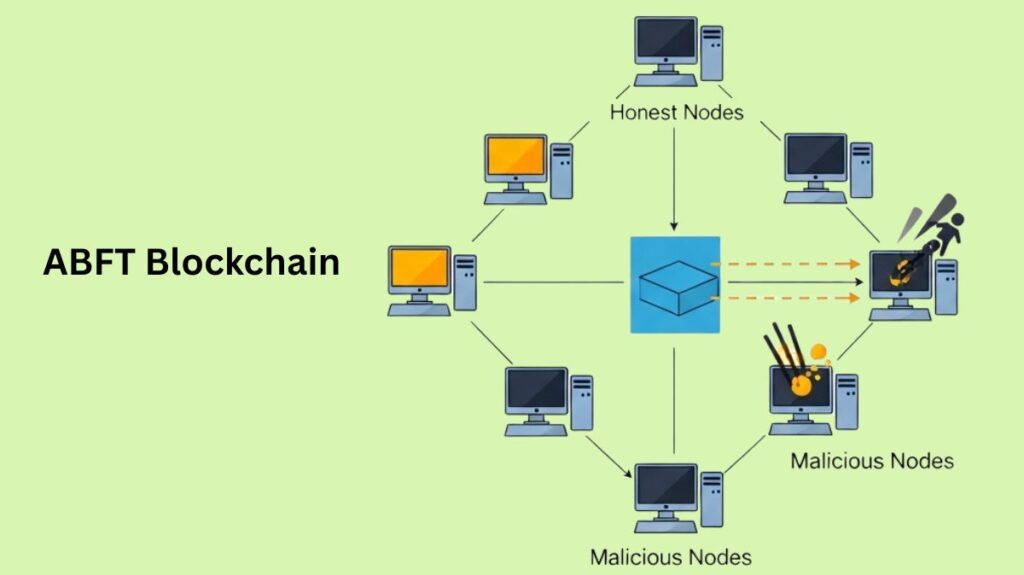ABFT Blockchain

In distributed systems, the extremely robust consensus technique known as Asynchronous Byzantine Fault Tolerance (ABFT) makes sure the network is safe and operates properly even if some of its nodes are compromised or act maliciously. This class of consensus protocols is made to function in an asynchronous network setting with no upper limits on clock skews or message delays, and the potential for malicious node behavior (Byzantine faults).
ABFT Overview
Byzantine Fault Tolerance (BFT)
ABFT is an extension of Byzantine Fault Tolerance (BFT). BFT describes a distributed network’s capacity to come to a consensus or agreement on a single value even in the event that some nodes are unresponsive or give false or malicious information. A BFT mechanism prevents system failures by reducing the impact of malfunctioning nodes through collaborative decision-making. The Byzantine Generals’ Problem demands generals to agree on a strategy even if some are traitors.
This assures that all loyal generals take the same action and that a few traitors cannot force them to take a bad one. A consensus can be formed if at most m processors are defective, which strictly means that more than two-thirds of the total processors must be honest, in order for BFT to be obtained if there are 3m+1 correctly operating processors. Incorrect or misleading results, failures to return a result, or giving different outcomes to different sections of the system are examples of byzantine failures.
Asynchronous Nature
One of the main characteristics that sets ABFT apart is its asynchronous nature. ABFT functions without any time limits or presumptions regarding message delivery timings, in contrast to classical BFT, which makes assumptions about a known upper bound on message delivery times or a degree of synchronization between nodes. This means that even if messages from trustworthy nodes come late, lost, or out of sequence, the system will work as intended. The Internet and other practical networking systems are frequently asynchronous, meaning that message delivery is not always guaranteed within a specific time window.
Ensuring Liveness and Safety
Ensuring liveness (the system finally advances and makes a decision) in a network that is entirely asynchronous is a fundamental difficulty for ABFT protocols. In a totally asynchronous environment, protocols such as Practical Byzantine Fault Tolerance (PBFT), which assume “weak asynchronous” circumstances to establish safety (all correct nodes agree on the same value), typically cannot guarantee liveness. Byzantine fault tolerance was made feasible with the help of PBFT, which was created to function well in asynchronous systems (where there is no upper limit on when a request would be answered).
Relevance and Applicability
ABFT is especially significant in decentralized systems, such as blockchain networks, where dependability and integrity are essential despite errors or attacks. It is more scalable and useful for distributed systems in the real world since it can operate without stringent time constraints, particularly those with high latency or erratic connectivity, like international networks. Its capacity to withstand a sizable number of malicious or malfunctioning nodes while preserving system performance and integrity makes it one of the most secure consensus models.
Important Algorithms and Applications
HoneyBadgerBFT (HBBFT)
Specifically referred to as an asynchronous BFT system, HoneyBadgerBFT (HBBFT) handles atomic broadcast and consensus. It is made to withstand hostile network controllers that would cause communications to be delayed, rendering weak synchronous BFT protocols (such as PBFT) useless. In suboptimal synchronous network conditions, it can scale up to a thousand nodes and perform thousands of transactions per second.
Hedera Hashgraph
According to its creator, the Hedera Hashgraph is Asynchronous Byzantine Fault Tolerant, meaning it can function even in the face of significant Internet outages. As long as enough messages are transmitted, its gossip protocol is intended to advance. One platform that makes use of ABFT is the Hedera network.
HotStuff
This BFT protocol, which was first presented by VMware Research, functions by assuming a partially synchronous network. To reduce communication complexity, it makes use of cryptographic hash algorithms and threshold signatures. HotStuff uses voting and certain commit rules to ensure safety and guarantees liveness using a “Pacemaker” component. It is the fundamental agreement for LibraBFT. By switching from a mesh to a star communication topology, HotStuff further enhances performance while drastically lowering communication complexity in contrast to conventional PBFT-style protocols.
Practical Byzantine Fault Tolerance (PBFT)
Practical Byzantine Fault Tolerance (PBFT) is a popular BFT algorithm, despite the fact that it depends on poor synchrony for liveness. Because of its high communication overhead, which grows exponentially with each node, it functions best when there are few nodes. A primary (leader) node broadcasts requests to secondary (backup) nodes, and the client receives m+1 replies (where m is the maximum number of defective nodes) to consider the request served. This is how PBFT handles client requests.
ByzCoin and Algorand
Some algorithms are characterised as “Asynchronous, but progress rely on the process of synchrony” by ByzCoin and Algorand.
FastBFT
“Asynchronous, but achievable liveness only under weak synchrony” is the description of FastBFT.
Also Read About Distributed Consensus Blockchain Importance And Challenges
Effectiveness of Communication
Certain ABFT techniques, such as communication trees, communal signatures, or unique ACS reduction with threshold encryption, improve scalability. It is crucial to remember that investing in cryptocurrency carries a high risk, and one should be ready to lose all of their money because there is no guarantee that anything will go wrong.
